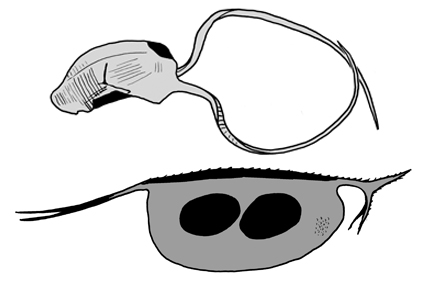References
- Adamczak, F. (1965) On some Cambrian bivalved Crustacea and egg cases of the Cladocera. Stockholm Contributions in Geology, 13, 27–34.
- Adamowicz, S.J., Petrusek, A., Colbourne, J.K., Hebert, P.D.N. & Witt, J.D.S. (2009) The scale of divergence: A phylogenetic appraisal of intercontinental allopatric speciation in a passively dispersed freshwater zooplankton genus. Molecular Phylogenetics and Evolution, 50, 423–436. https://doi.org/10.1016/j.ympev.2008.11.026
- Benzie, J.A.H. (2005) The genus Daphnia (including Daphniopsis) (Anomopoda: Daphniidae). Guides to the Identification of the Microinvertebrates of the Continental Waters of the World 21. Kenobi Productions, Ghent, Belgium and Backhuys Publishers, Leiden, 376 pp.
- Bernatowicz, P., Radzikowski, J., Paterczyk, B., Bebas, P. & Slusarczyk, M. (2018) Internal structure of Daphnia ephippium as an adaptation to dispersion. Zoologischer Anzeiger, 277, 12–22. https://doi.org/10.1016/j.jcz.2018.06.006
- Colbourne, J.K., Pfrender, M.E., Gilbert, D., Thomas, W.K., Tucker, A., Oakley, T.H., Tokishita, S., Aerts, A., Arnold, G.J., Basu, M.K., Bauer, D.J., Cáceres, C.E., Carmel, L., Casola, C., Choi, J.-H., Detter, J.C., Dong, Q., Dusheyko, S., Eads, B.D., Fröhlich, T., Geiler-Samerotte, K.A., Gerlach, D., Hatcher, P., Jogdeo, S., Krijgsveld, J., Kriventseva, E.V., Kültz, D., Laforsch, C., Lindquist, E., Lopez, J., Manak, J.R., Muller, J., Pangilinan, J., Patwardhan, R.P., Pitluck, S., Pritham, E.J., Rechsteiner, A., Rho, M., Rogozin, I.B., Sakarya, O., Salamov, A., Schaack, S., Shapiro, H., Shiga, Y., Skalitzky, C., Smith, Z., Souvorov, A., Sung, W., Tang, Z., Tsuchiya, D., Tu, H., Vos, H., Wang, M., Wolf, Y.I., Yamagata, H., Yamada, T., Ye, Y., Shaw, J.R., Andrews, J., Crease, T.J., Tang, H., Lucas, S.M., Robertson, H.M., Bork, P., Koonin, E.V., Zdobnov, E.M., Grigoriev, I.V., Lynch, M. & Boore, J.L. (2011) The ecoresponsive genome of Daphnia pulex. Science, 331, 555–561. https://doi.org/10.1126/science.1197761
- Collins, D. (1996) The “evolution” of Anomalocaris and its classification in the arthropod class Dinocarida (nov.) and order Radiodonta (nov.). Journal of Paleontology, 70, 280–293. https://doi.org/10.1017/S0022336000023362
- Cooper, R.A., Maxwell, P.A., Crampton, J.S., Beu, A.G., Jones, C.M. & Marshall, B.A. (2006) Completeness of the fossil record: estimating losses due to small body size. Geology, 34, 241–244. https://doi.org/10.1130/G22206.1
- Cornetti, L., Fields, P.D., Van Damme, K. & Ebert, D. (2019) A fossil-calibrated phylogenomic analysis of Daphnia and the Daphniidae. Molecular Phylogenetics and Evolution, 137, 250–262. https://doi.org/10.1016/j.ympev.2019.05.018
- Donoghue, P.C.J. & Purnell, M.A. (2009). Distinguishing heat from light in debate over controversial fossils. BioEssays, 31, 178–189. https://doi.org/10.1002/bies.200800128
- Dumont, H.J. & Negrea, S. (2002) Introduction to the Class Branchiopoda. Guides to the Identification of the Microinvertebrates of the Continental Waters of the World 19. Backhuys Publishers, Leiden, 397 pp.
- Frey, D.G. (1991) A new genus of alonine chydorid cladocerans from athalassic saline waters of New South Wales, Australia. Hydrobiologia, 224, 11–48. https://doi.org/10.1007/BF00006361
- Glagolev, S.M. (1983) [Structure of ephippium surface in Daphniidae (Crustacea, Cladocera) by the data of scanning electroni microscopy]. Zoologicheskii Zhurnal, 62, 1422–1424.
- Kotov, A.A. (2006) Adaptations of the Anomopoda (Cladocera) for benthic mode of life. Zoologicheskii Zhurnal, 85 (9), 1043–1059. https://doi.org/10.1134/S0013873806110157
- Kotov, A.A. (2007) Jurassic Cladocera (Crustacea, Branchiopoda) with a description of an extinct Mesozoic order. Journal of Natural History, 41, 13–37. https://doi.org/10.1080/00222930601164445
- Kotov, A.A. (2009a) New finding of Mesozoic ephippia of the Anomopoda (Crustacea: Cladocera). Journal of Natural History, 43 (9/10), 523–528. https://doi.org/10.1080/00222930802003020
- Kotov, A.A. (2009b) Revision of extinct Mesozoic family Prochydoridae Smirnov, 1992 (Branchiopoda: Cladocera) with discussion of its phylogenetic position. Zoological Journal of the Linnean Society, 155, 253–265. https://doi.org/10.1111/j.1096-3642.2008.00412.x
- Kotov, A.A., Kuzmina, S.A., Frolova, L.A., Zharov, A.A., Neritina, A.N. & Smirnov, N.N. (2019) Ephippia of the Daphniidae (Branchiopoda: Cladocera) in Late Caenozoic deposits: untapped source of information for palaeoenvironment reconstructions in the Northern Holarctic. Invertebrate Zoology, 16, 183–199. https://doi.org/10.15298/invertzool.16.2.06
- Kotov, A.A., Maiphae, S. & Sanoamuang, L. (2005) Revision of Macrothrix paulensis-like species (Anomopoda, Cladocera, Brachiopoda) in Asia, and phylogeny of the paulensis-group. Archiv für Hydrobiologie, Supplement 151 (3), 269–299.
- Kotov, A.A. & Taylor, D.J. (2011) Mesozoic fossils (>145 Mya) suggest the antiquity of the subgenera of Daphnia and their coevolution with chaoborid predators. BMC Evolutionary Biology, 11, 129. https://doi.org/10.1186/1471-2148-11-129
- Kotov, A.A. & Wappler, T. (2015) Fossil Daphnia (Ctenodaphnia) Dybowski & Grochowski (Branchiopoda: Cladocera) in Cenozoic volcanogenic lakes in Germany, with discussion of their indicator value. Palaeontologica Electronica, 18.2.40A, 1–9. https://doi.org/10.26879/542
- Mergeay, J., Verschuren, D. & De Meester, L. (2005) Daphnia species diversity in Kenya, and a key to the identification of their ephippia. Hydrobiologia, 542, 261–274. https://doi.org/10.1007/s10750-004-4952-6
- Peng, J., Slater, S.M., McLoughlin, S. & Vajda, V. (2023) New species of Kuqaia from the Lower Jurassic of Sweden indicates a possible water flea (Crustacea: Branchiopoda) affinity. PLoS ONE, 18 (6), e0282247. https://doi.org/10.1371/journal.pone.0282247
- Schultz, T.W. (1977) Fine structure of the ephippium of Daphnia pulex (Crustacea: Cladocera). Transactions of the American Microscopical Society, 96, 313–321. https://doi.org/10.2307/3225860
- Scourfield, D.J. (1901) The ephippium of Bosmina. Journal of the Quekett Microscopical Club, Series 2, 8, 51–56.
- Scourfield, D.J. (1902) The ephippia of the lynceid Entomostraca. Journal of the Quekett Microscopical Club, Series 2, 8, 217–244.
- Smirnov, N.N. & Kotov, A.A. (2009) Morphological Radiation with Reference to the Carapace Valves of the Anomopoda (Crustacea: Cladocera). Internationale Revue der gesamten Hydrobiologie und Hydrographie, 94 (5), 580–594. https://doi.org/10.1002/iroh.200811121
- Smirnov, N.N. (1971) Chydoridae fauny mira. Rakoobraznie, 1. Fauna USSR, Leningrad, 531 pp. [English translation: Chydoridae of the world. Israel Program for Scientific Translations, Jerusalem, 1974]
- Szeroczyńska, K., Sarmaja-Korjonen, K. (2007) Atlas of Subfossil Cladocera from Central and Northern Europe. Friends of the Lower Vistula Society, Świecie, 83 pp.
- Van Damme, K. & Kotov, A.A. (2016) The fossil record of the Cladocera (Crustacea: Branchiopoda): evidence and hypotheses. Earth-Science Reviews, 163 (2016), 162–189. https://doi.org/10.1016/j.earscirev.2016.10.009
- Van Damme, K., Cornetti, L., Fields, P.D. & Ebert, D. (2022) Whole-Genome Phylogenetic Reconstruction as a Powerful Tool to Reveal Homoplasy and Ancient Rapid Radiation in Waterflea Evolution. Systematic Biology, 71 (4), 777–787. https://doi.org/10.1093/sysbio/syab094


